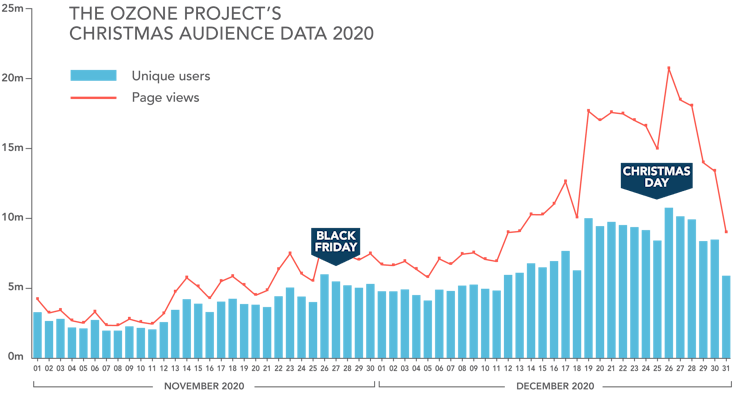How to time your marketing effectively in the run-up to Christmas
This Christmas is set to be very different from the last, so to execute effective advertising campaigns brands must plan to peak at the right times, when consumers are most engaged with relevant content.

After a Christmas like no other in 2020, when much of the country was under lockdown, marketers need to be alert to consumer trends when planning their festive online advertising this year.
Most advertisers would once have planned their Christmas campaigns in a similar way each year. But times have changed. Consumer behaviour is still being strongly influenced by the pandemic, as well as nationwide supply shortages in numerous sectors, and advertisers must take all this into account.
According to The Ozone Project – the publisher-built digital advertising platform that serves ads to 44 million readers of the UK’s major news, entertainment and lifestyle publications – almost 60% of advertisers and agencies went into last year’s ‘golden quarter’ planning to operate in a similar way to previous years. Just 10% said they would move Christmas campaigns earlier than usual and 11% planned their launch later.
Unless brands shift their strategies in 2021, many will probably miss out on key opportunities to reach engaged consumers while they’re actively researching purchases, reading premium content relevant to their categories.
Start campaigns early to reach shoppers looking to beat the rush
In particular, marketers need to be aware of growth in festive content consumption starting early and peaking at key moments. Based on audience behaviour in 2020, brands can expect to see significant growth in consumption of content in key categories in the run up to Christmas 2021. This year’s upticks started as early as August, thanks in part to the predictions of supply chain issues that might limit the selections retailers can offer shoppers during the festive season.
Rebecca Naish, head of marketing and licensing at toy chain The Entertainer, says there are a number of pressures pushing both advertisers and consumers to think about Christmas earlier than usual this year.
“There are challenges facing the retail and toy industry, from the shipping crisis to the HGV driver shortage,” she says. “We have planned customer messaging online to encourage people to shop early and ‘beat the rush’ so they can secure the toys that are at the top of their children’s Christmas wish-list.”
Britvic’s consumer experience director Andrea Bernhardt says digital advertising is increasingly important for its brands and that staying ahead of consumer needs is the key to unlocking relevance.
“Last year younger shoppers were more likely to start Christmas grocery shopping earlier than usual and we expect to see that behaviour again this year,” she says.
Bernhardt adds that when planning online advertising and content it is crucial to consider where the brand has the right to win with shoppers, and to create consumer experiences.
“We are creating holistic experiences across paid, owned and earned channels to drive more relevancy and effectiveness in digital,” she says. “With our digital-first approach we are using technology to allow for deeper insights and personalised experiences, so we can optimise marketing initiatives and messaging around Christmas.”
Phase your campaign around the key peaks

According to The Ozone Project’s data, the festive audience on premium publishers’ sites grows steadily from October through to Black Friday, which takes place this year on 26 November. The week of Black Friday 2020 saw a 108% jump in page views and an 82% rise in unique user growth compared to the first week of November. Video gaming content saw a whopping 382% increase in page views between those same weeks, with significant growth too in the television, shopping, style and fashion, and tech and computing categories.
After the first Black Friday peak, the audience then builds again from early December until after Christmas. From the beginning of November last year to the final week in December, average weekly page views and unique users grew by 74% and 48% respectively across the Ozone publisher network.
Brands should see these figures as indicative of when their consumers are in-market and receptive to advertising. Boots, for example, will be focusing its campaign phasing based on key peaks and trends such as these, says chief marketing officer Pete Markey.
“We’ve got a lot of learnings from previous festive seasons, including the build-up to Black Friday, so our plan for this year is to flex our spend around the key dates and the build-up to them, to ensure strong customer engagement in the moments that matter,” he says.
Boots is known for its active programme of listening to customers to ensure its messaging is in line with people’s expectations, and Markey says there is a real opportunity, when planning Christmas online advertising in 2021, to connect with consumers even more deeply. He points out the need to invest in the brand to attract its core audience while also targeting other shoppers who have gifting needs.
Focus on festive content, even in January
Seasonal content – both branded content and editorial that provides context for relevant advertising – is crucial to advertisers’ plans, and consumers who have left memories of their summer holidays behind will engage quickly with Christmas-related articles.
According to Markey: “As people look ahead to a ‘proper’ Christmas, online festive-related content will be important. Last year we ran a Christmas showcase with a celebrity presenter to cover our gifting range, and this saw strong engagement.”
“Reading trends from our publisher data gives a very clear indication of when consumers switch into Christmas mode,” adds Sophie Raptis, client director at The Ozone Project. “We see a rapid scaling of those interested in Christmas content from early October. This trend is replicated across many of the content types associated with the festive season, particularly family-based, shopping, and gifting and promotional-related content.”
Raptis says advertisers should remain focused on aligning their campaigns with seasonal content post-Christmas too, because consumers continue to read it after Boxing Day and throughout the winter sales, when they are searching online for bargains to cheer themselves up during the cold and dark days of January. Indeed, in 2020, the three days from Boxing Day saw more unique users and page views on publishers’ content from their festive audiences than any day in the previous week, suggesting there’s a bigger opportunity targeting people with ads then than in the last days before Christmas.
Last year, there was also significant growth in engagement (as measured by page views) with winter sales content between the Christmas week and its peak in the week beginning 25 January. That week, the publications Ozone represents amassed a total of 113 million page views on content in key sales categories, up 80% from the week of 21 December.
Take note of unique trends in 2021
When planning online advertising this Christmas, marketers and their agencies must acknowledge the factors unique to this year. Supply chain pressures around toys, for example, could dim the sparkle for families. Advertisers also need to consider the challenges and opportunities from people working from home, who may want more of their Christmas shopping delivered to their doors.
One potential cloud for advertisers suppressing product demand could be consumers rewrapping and regifting products they purchased last year but were unable to present to family and friends.
However, the likelihood is consumers will want to trade up and make their traditional Christmas more of a premium experience. Their spending levels obviously fell in 2020 compared to 2019 but, according to PwC data, a quarter of them plan to splurge the extra money they saved during lockdown on some Christmas cheer.
Brands will also want to shape their messaging according to trends they see in their own sectors. Darbi Donaldson, director of UK digital marketing at BMG, says in the run-up to Christmas 2021 the record company is taking the opportunity to reframe campaign messaging around its artists and gifting.
“There’s a shift in messaging from encouraging a direct purchase for oneself to considering a gifted purchase for your nearest and dearest,” she says. “There’s an adjustment in audience targeting too. We are widening our advertising groups from fans to friends of fans with our gifting-based messaging.”
She adds that in the world of streaming, BMG will implement tactics to re-promote previous releases around the holidays. The marketing teams will pitch for inclusion in music fans playlists when they are organising parties for family and friends.
“Artists with seasonal catalogues or tracks in their armoury will see a pronounced increase in consumption during this period, and we will look to amplify that as much as possible via social and advertising activity.”
If advertisers are to make the most of the opportunities for their sector, and for reaching consumers more widely, they need to know when their target audience is most likely to be in the festive spirit, and plan their campaigns in plenty of time. After many people’s Christmases were effectively cancelled last year, consumers are planning to make up for it in 2021, but if marketers assume their pre-pandemic strategies are still fit for purpose, they could miss out badly on the additional consumer spending that’s up for grabs.






